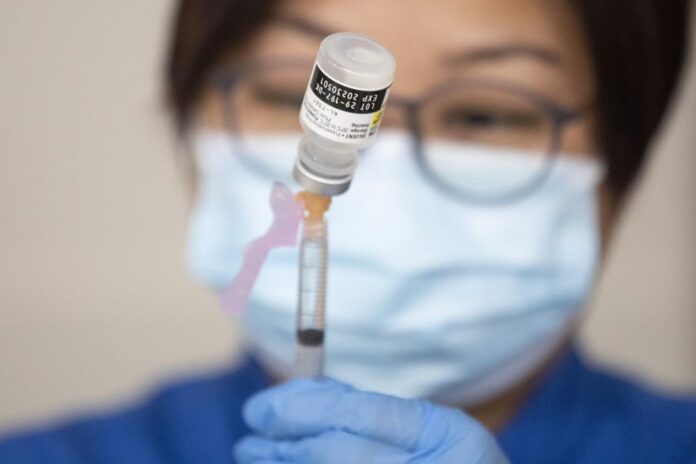COVID-19 vaccination rates among Ontario’s urban Indigenous population were lower compared with the general population despite priority rollout, according to a new study.
The research published in the Canadian Medical Association Journal (CMAJ) on Tuesday found that between March 2020 and December 2021, the two-dose COVID-19 vaccine uptake for First Nations, Inuit and Métis people living in Toronto and London, Ont., was 20 per cent lower than the overall population.
However, the study also showed that COVID-19 testing rates in the two cities were 10 per cent higher among the Indigenous community compared with local and provincial rates.
Researchers looked at data including 1,087 Indigenous people above the age of 15 in Toronto and London.
“Indigenous people were one of the three very first priority groups for access to vaccine in Ontario, along with health-care workers and people that were living in long-term care homes, but despite that prioritization, we’re actually still seeing significant gaps,” said co-author Janet Smylie, who is a family doctor at St. Michael’s Hospital and professor at the University of Toronto.
Booster rates for third doses also continue to lag significantly for this group, she said.
Calgary’s Indigenous and Sikh communities partner to overcoming vaccine hesitancy – Feb 4, 2022
Barriers in access to culturally safe health centres, systemic racism in hospitals and a lack of trust in biomedicine due to discriminatory colonial policies were responsible for the lower vaccine coverage, Smylie said.
As of last week, more than 86 per cent of Canadians aged five and up have been fully vaccinated with two doses. And nearly half the total population has been boosted with a third dose.
Jaris Swidrovich, a First Nations pharmacist and assistant professor at the University of Toronto who was not involved in the study, said he was concerned but not surprised by the low uptake as documented by the CMAJ research.
He said a strong history of experimentation, current policies and practices like forced and coerced sterilization of Indigenous women, and experiences of “racist health care” were all likely contributing factors.
Trending Stories
Montreal mom demands apology for police intervention at sons’ lemonade stand
Canadian archivist uncovers ‘very profound’ residential school records in Rome
“There’s certainly a number of very valid reasons why Indigenous peoples may choose to either delay or to not receive an immunization,” he said.
Because Indigenous people have historically not been prioritized for other basic necessities like drinking water, housing and education, the priority vaccination during a global pandemic has raised skepticism and questions, Swidrovich added.
“Am I being experimented on again? Are we seeing how the vaccine works in us first before it’s offered to the general population across Canada?” he said.
First Nations collaborate on cross-border vaccine clinic – Jun 21, 2021
First Nations communities across Canada have been disproportionately impacted by the COVID-19 pandemic, according to federal government data.
In January 2022, the Omicron variant of COVID-19 increased the rate of reported active cases but it has since gone down.
Since December 2021, Canada’s National Advisory Committee on Immunization (NACI) has strongly recommended COVID-19 vaccine boosters for adults in the First Nations, Métis and Inuit communities.
Given the threat of another potential wave this fall and winter, Smylie said she was really worried about the risks to the Indigenous community, particularly those living in low-income and crowded settings.
Smylie said the best way to help increase vaccine uptake is to rely on community-led efforts and social networks that have helped tackle the mistrust in the vaccines during the pandemic.
Two-thirds of Canadians would take COVID-19 booster without hesitation: poll – Jul 21, 2022
Swidorich also pointed to the success of COVID-19 vaccination drives in both urban and non-urban settings where shots are offered in a more comfortable and culturally sensitive atmosphere.
He said public health messaging and the way vaccines are promoted to targeted groups is important.
“We have absolutely seen the success of improving Indigenous people’s vaccination rates through Indigenous-led programing and Indigenous-led clinics, whether that’s urban or non-urban.”
© 2022 Global News, a division of Corus Entertainment Inc.



